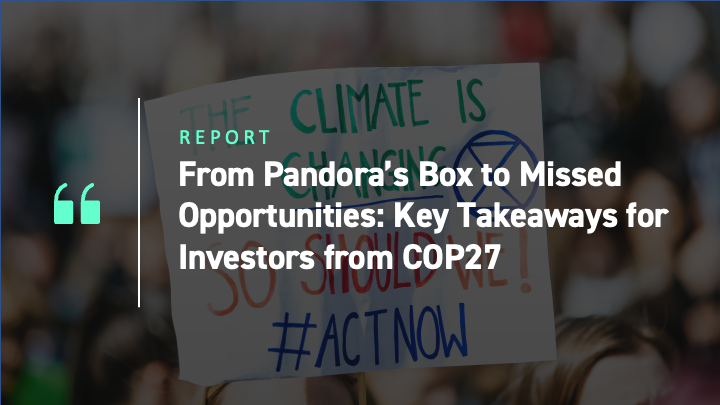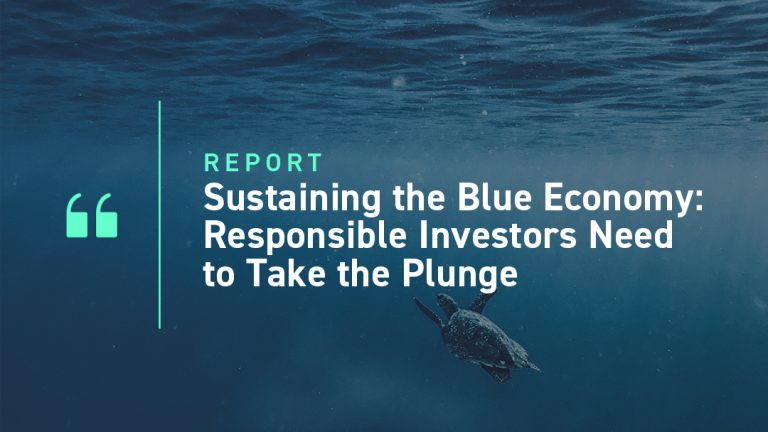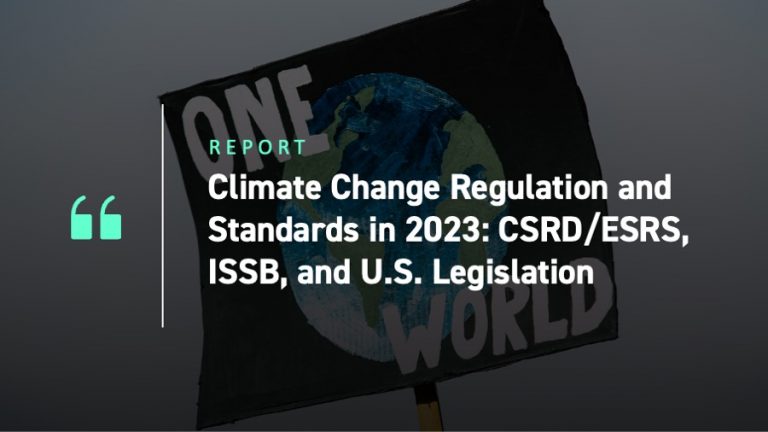The Conference of the Parties (COP) climate change meetings have taken place for the last 20 years, and now represent the largest annual conference held by the United Nations. The COP meetings involve negotiations on the implementation of global climate change agreements, and include representation from governments across the world, as well as representatives from other stakeholder groups such as civil society and industry. The COP discussions have a significant impact on the way global business is done, and so are keenly watched by investor and business groups alike.
This year’s COP27 took place in November in Sharm el-Sheikh, Egypt. Proceedings were closely watched by Institutional Shareholder Services, and the following reports have been prepared by the ISS ESG & ISS Corporate Solutions business units:
- From Pandora’s Box to Missed Opportunities: Key Takeaways for Investors from COP27; and
- Governments Stall, Corporates Forge Ahead: Key Takeaways for Companies from COP27
Key Takeaways
- Mitigation – A missed opportunity increases the risk of a disorderly transition:
- Governments at COP27 showed a lack of ambition and did not reach an agreement on further action to mitigate emissions.
- The final agreement makes no mention of phasing out oil and gas.
- Delaying climate mitigation action increases the risk of a disorderly transition, and therefore transition risks for investors.
- Loss and Damage Fund – Opening of a Pandora’s Box on liabilities for historic emissions:
- The issue of creating a specific fund for loss and damage, referring to irreversible damage caused by climate change in vulnerable countries, was added to the official agenda and adopted for the first time at COP27.
- The Loss and Damage Fund is complementary to already existing climate funds focused on mitigation and adaptation.
- Discussions around accountability and liabilities of high-emitting countries reinforces discussions around so-called windfall taxes that could be imposed on the oil & gas sector to finance the fund.
Introduction
Last year’s COP26 concluded with the signing of the Glasgow Climate Pact by 197 countries reaffirming the Paris Agreement’s goal of limiting temperature rises to 1.5°C, with pledges from signatories to further cut their greenhouse gas emissions.
This year’s COP27 was to be the “implementation COP,” with the objective of translating commitments into credible action plans in order to keep the 1.5°C goal within reach.
This objective has not been achieved, however, as no stronger commitments to the Glasgow Climate Pact were agreed upon in the Sharm el-Sheikh Implementation Plan. Despite the failure to tackle climate change mitigation, the parties agreed on a momentous deal to create a Loss and Damage Fund, which will set in motion the precedent for developed countries, who are most responsible for historical emissions, to provide compensation to vulnerable, developing countries that are already feeling the harmful impacts of climate disasters the most.
These two developments – the lack of stronger commitments on emissions reductions and a deal to create a Loss and Damage Fund – are the main takeaways from COP27. In the following sections, ISS ESG will expand on the implications of the developments for institutional investors. For insights into the implications for corporate issuers, please see this companion piece.
Mitigation – A Missed Opportunity Increases the Risk of a Disorderly Transition
Ahead of COP27, in a statement coordinated by The Investor Agenda and its seven Founding Partners (AIGCC, CDP, Ceres, IGCC, IIGCC, PRI, and UNEP FI), 602 institutional investors representing almost $42 trillion in assets under management called on all governments to strengthen and align their 2030 targets in their Nationally determined contributions (NDCs) with the goal of limiting global temperature rises to 1.5°C and to implement the necessary policy actions to support these targets, including:
“setting a deadline to phase out thermal coal power and fossil fuel subsidies, and establishing plans and targets to peak and then phase out the use of other fossil fuels, in line with credible 1.5°C pathways.”
There were therefore high expectations that countries would raise their mitigation ambition and decide on actions to implement these commitments. However, very little was achieved beyond what had already been agreed at COP26. A resolution to peak emissions by 2025 was taken out, and the Sharm el-Sheikh implementation plan still makes no mention of phasing out oil and gas, but instead sticks to the Glasgow Climate Pact to accelerate “efforts towards the phasedown of unabated coal power.”
While governmental ability to deliver NDCs depends on the global financial system to mobilize public and private capital in low-carbon solutions such as renewable energy, investors often emphasize the need for policy incentives to redirect investments to the scale needed to achieve the Paris Agreement’s goals.
It is therefore not surprising that after seeing the final COP27 implementation plan, some investors expressed concern about the possibility of reaching the 1.5°C limit target. Voices proliferate questioning whether 1.5°C is still alive. While mitigation remains key, this raises the question for investors of how to invest in adaptation and related opportunities and how to make existing investments resilient towards the inevitable physical risks.
But delaying climate mitigation action also increases the risk of a disorderly transition, defined by the European Central Bank as:
“a situation in which climate policies and regulations are implemented late with regard to the climate targets and cannot be fully anticipated by investors.”
This makes it all the more important for investors to anticipate and manage these risks effectively: by, for example, setting science-based short-, medium-, and long-term emission reduction targets; engaging with high-emitting companies; and aligning their investment strategies with their targets.
An increasing number of investors already recognize the need for a collective mitigation effort by committing to reach Net Zero by 2050 through Net Zero alliances. The UN Secretary-General’s High-Level Expert Group on Net-Zero Commitments released a report during COP27, serving as a “how-to guide to ensure credible, accountable net-zero pledges” by industry, financial institutions, cities, and regions. Following the Expert Group’s guidelines, “[Net-Zero] plans must be ambitious, have integrity and transparency, be credible and fair.”
In this context, investors might need to navigate an environment where civil society and their clients ask for ambitious climate action while the policy frameworks put in place by governments for companies’ action remain off-track from the 1.5°C target.
Loss and Damage Fund – Opening a Pandora’s Box on Liabilities for Historic Emissions
After many twists and turns in the discussions, the 197 “parties” (i.e., countries) present at COP27 agreed to establish a Loss and Damage Fund to help vulnerable countries most affected by climate change recover from climate disasters.
As explained by the Australian organization the Climate Council:
“loss and damage funding refers to finance that directly addresses unavoidable climate change catastrophes that developing countries are particularly vulnerable to.”
This funding could for instance be directed at the reconstruction of homes and infrastructure after a climate-related disaster. It is different from climate finance, which refers to:
“developed countries giving money to help developing countries build clean energy systems, reduce emissions, and cope with the overall impacts of climate change.”
As Shami Nissan, head of sustainability at investment firm Actis, points out:
“finance for sustainability can be divided mainly into three themes – mitigation (e.g. investing in renewables), adaptation and loss and damage (from climate damage that has already been incurred).”
A climate finance fund has existed since Copenhagen’s COP15 in 2009, when developed countries committed to a collective goal of mobilizing $100 billion per year by 2020 (which was extended to 2025 at COP21 in Paris), to finance climate change mitigation and adaptation action in developing countries. The issue of creating a specific fund for loss and damage was added to the official agenda and adopted for the first time at COP27, however. The details of the funding arrangements (such as which countries will pay; how much they will pay; and which developing countries will be eligible to receive the funding) are to be formalized at COP28 in Dubai.
An agreement to create a loss and damage fund at a U.N. climate summit is a major step forward for the Global South. Developed countries have resisted the idea for decades, citing concerns that they could be held legally liable for historic emissions. The discussion around liabilities, or more candidly “the polluters must pay,” using the words of the UN Secretary-General António Guterres, reinforces discussions around so-called windfall taxes, an extra levy imposed by a government on certain industries to redistribute excess profits in one area to raise funds for another. The oil and gas sector could be targeted to redirect some of its revenue to help pay for the effects incurred by climate disasters, says the Secretary-General. The accompanying decrease in profitability and increase in liability risks for high-emitting sectors would have clear implications for investors.
Conclusion: Conflicting Signals and Increased Risk for Investors
COP27 failed to address climate change mitigation, focusing instead on its impacts. By demonstrating a lack of credible commitment to their pledges, governments are sending conflicting signals to investors, who may conclude that they should scale back their own ambitions and focus on adaptation instead. The increased risk of a disorderly transition through delayed mitigation efforts, however, and the opening of the Pandora’s Box of liabilities for historic emissions via the loss and damage fund, increases the transition risks for investors who therefore have, more than ever, an interest in acting quickly to mitigate these risks.
Explore ISS ESG solutions mentioned in this report:
- Use ISS ESG Climate Solutions to help you gain a better understanding of your exposure to climate-related risks and use the insights to safeguard your investment portfolios.
By: Livia Wack, Sr. Associate Climate Analytics, ISS ESG
Patricia Dörig, Associate Climate Methodology, ISS ESG




